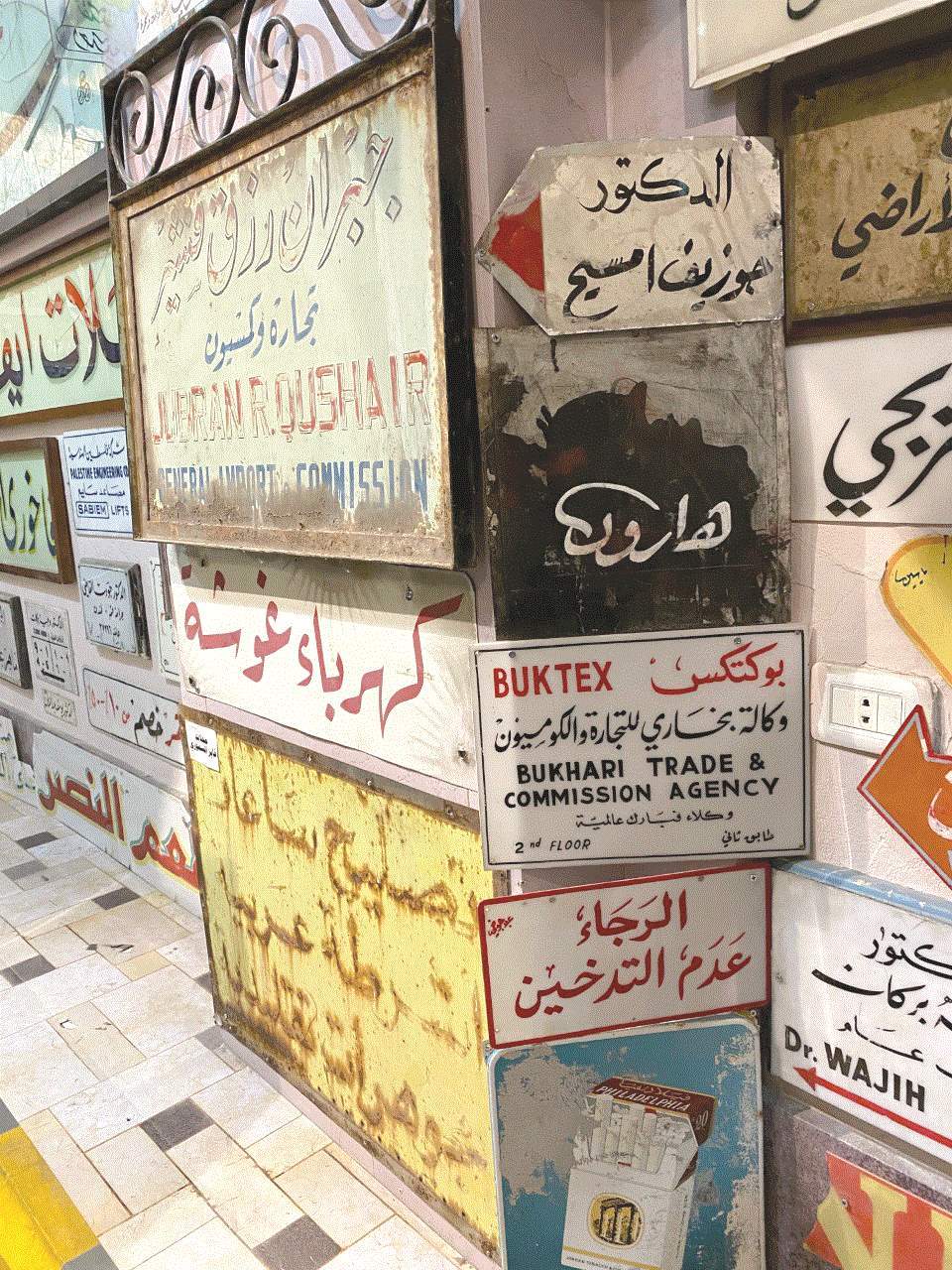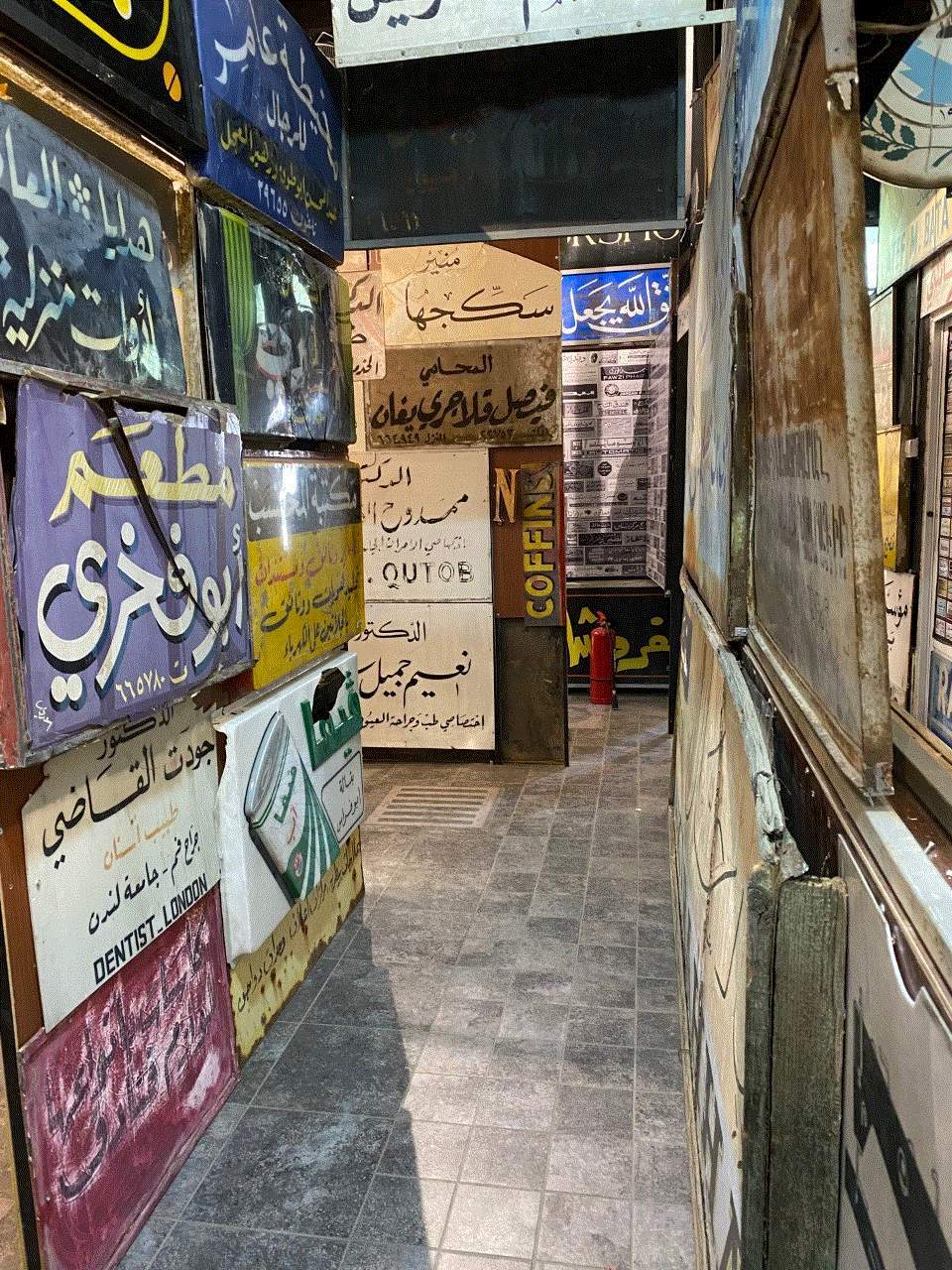AMMAN — It’s a sign, but so much more, it illustrates Jordan’s rich and diverse history. Sign boards have changed a lot over the past 70 years. For anyone interested in studying those changes up close and personal there is one place, the
“Old Signs of Amman” museum located in
downtown Amman just above the historic Café Central.
اضافة اعلان
Gazi Khattab, who was born in 1962, created this museum to allow anyone to have the chance to discover Amman’s history in a brand new way. At the museum the visitor can find hand drawn and painted signs from as far back as 1949.
 A collection of old sign boards at the Old Signs of Amman museum in downtown (Photos: Aisha Ahmed/Jordan News)
A collection of old sign boards at the Old Signs of Amman museum in downtown (Photos: Aisha Ahmed/Jordan News)
Khattab chose this particular location for several reasons, the first was that sign boards he collected over the years were originally from the down town area, and he wanted to maintain that contextual link between the museum’s physical location and the sign boards on show.
“Another reason for choosing this location is that it is just above Café Central that was established in the thirties of the last century, which makes it one of the oldest places in downtown,” Khattab told
Jordan News in an interview.
His establishment of this museum followed years of interest in and passion for Arabic calligraphy, which was a hobby of his. From when Khattab was in first grade until he was 11 years old, Khattab used to look at magazines, books, newspaper titles and sign boards above store fronts and the fonts they used. As he got older, he would walk daily from Al-Wehdat refugee camp to Marka to see the largest number of sign boards possible.
 A collection of old sign boards at the Old Signs of Amman museum in downtown (Photos: Aisha Ahmed/Jordan News)
A collection of old sign boards at the Old Signs of Amman museum in downtown (Photos: Aisha Ahmed/Jordan News)
In 1980, Khattab took a photo under the Al-Sarsour shop sign board in downtown. This photo travelled with him to Berlin where he studied the art of making signs and graphic design. Six years later he acquired that sign board which is now on display at the museum.
In 1986, Khattab started his journey to protect the old sign boards of Amman.
“I prefer signs to be outside where all people can see and enjoy the old face of Amman, but if they are in danger of being damaged or destroyed, I bring them to the museum to protect them,” he said.
Before he set up the museum, Khattab’s love for the city made him decide to stay in Amman after finishing his studies in Germany. In 1988, he opened a shop for making sign boards in Al-Quwasimah.
“I did not have the ability to keep up with calligraphers in Amman. So I bought a set of printable letters which caused calligraphers to revolt against me,” Khattab said. Following that, he worked on rehabilitating Arabic calligraphy and maintaining the legacy of old Amman through his museum.
 A collection of old sign boards at the Old Signs of Amman museum in downtown (Photos: Aisha Ahmed/Jordan News)
A collection of old sign boards at the Old Signs of Amman museum in downtown (Photos: Aisha Ahmed/Jordan News)
Khattab obtains his sign boards in many ways, some people donate them to the museum to preserve them and keep their childhood memories alive, and in some cases Khattab makes new sign boards for shop owners so he can get the old one.
“Actually, I am not the only one who created this place, but also all the individuals who loved the idea and gifted their old signs to the museum. With each sign the value of the place increases,” Khattab said.
“The most valuable signs I have cost me nothing as they were gifted to me by relatives of the shops and clinics owners to preserve their memories and have a place where they can come and visit the memories of their loved ones,” Khattab said. “Everything you buy is cheap compared to what people give you and the trust they put in you,” he added.
Khattab shared a few stories behind some of the signs he collected over the years. The oldest sign the museum has was created in 1949 by Albert, an Armenian calligrapher, for Robin Kechejian, who had a photographic equipment store.
 A collection of old sign boards at the Old Signs of Amman museum in downtown (Photos: Aisha Ahmed/Jordan News)
A collection of old sign boards at the Old Signs of Amman museum in downtown (Photos: Aisha Ahmed/Jordan News)
The sign board for the Mahmoud Jomaa clinic, arrived at the museum broken with pieces missing. “One day a lady came in with her mother and daughters. She was looking around for a sign and started shouting that she found her father’s sign. She took photos beside it and sent them to her brother. Now, the sign is complete as the story behind it is known,” Khattab said.
“The idea wasn’t to have a museum about signs and calligraphy, but to have a place that is a window on to memories and the longing for the places and people we lost,” he said.
Khattab does not interfere with how the old signs look, the only thing he does is clean those that have dust or dirty spots with a vacuum. He does not use chemical products in cleaning them. “Inside the museum it is hard for any sign to get damaged as they are protected from weather fluctuations,” Khattab said.
What distinguishes the Old Signs Amman museum from other museums in the Kingdom is the idea behind it. Each sign in the museum has connections with people, he said. “Some people see the sign of their fathers, neighbours, and loved ones and maybe the doctor’s clinic they used to go to when they were young. It also allows people to revisit their childhood memories,” Khattab said.
“It is important to preserve such signs because the art of handmade sign boards and calligraphy has disappeared somehow. Even calligraphers now tend to make signs using digital technology,” he added.
The museum also supports local calligraphers as it allows them to display their work and explain it to visitors. “Each month we give the opportunity to one calligrapher to show their work, to increase peoples’ love of Arabic calligraphy,” he said, adding that some people reserve the space in the museum to teach music.
The museum is open for all for free. Khattab believes that everyone should see the beauty of the old sign boards.
Each month around 6,000 people visit Old Signs of Amman, at an average of 200 visitors a day. “I do not think other museums in Jordan have this number of visitors,” he said, adding that what he loves the most about what he does is to see people interacting with the signs on show.
Khattab is planning to find a larger space to display his signs but without moving from his current location. On October 28, Khattab is preparing to give a TEDx talk at the Hashemite University on the Old Signs Amman museum.
One visitor to the museum told Jordan New: “The idea of the museum is new for me. I’ve traveled to many places but never saw a museum that displays the country’s signs and protects them. It is great to have such a place to visit and feel the vibes of the past century and have an overview of how people like my grandfather used to see the streets.”
Haneen, another visitor of Old Signs of Amman, said: “The museum is really beautiful, it makes you feel connected to the Amman we never knew, to see the ads from the past and the signs we do not have any more.”
Read more Around Jordan



